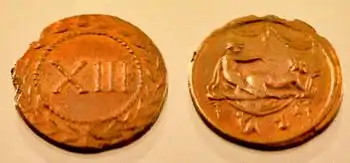Spintria
A spintria (plural, spintriae) is a small bronze or brass Roman token, possibly for use in brothels, although none of the literature on the spintriae contains any evidence to support this assertion. The tokens usually depict on the obverse a motif of sexual acts or symbols and a numeral in the range I - XVI on the reverse.

Name
Spintria was used by Suetonius to refer to young male prostitutes,[1] from Greek σφιγκτήρ (sphinktḗr, [anal] sphincter). In the 16th century, the name passed from the ancient sense of the persons committing outrageous acts--in other words, sexual and/or sensual acts outside what was considered the norm--(or the place where outrageous acts occurred, such as Tiberius' gardens on the isle of Capri) to the tokens themselves. Bette Talvacchia identifies the first usage of the term spintriae to refer to the tokens as occurring in Sebastiano Errizo's 1559 treatise, Discourse Concerning Ancient Medals (Sopra le Medaglie Antiche, Venice, 1559).[2]
Use
Some scholars, following Friedlander's (1886) suggestion that the tokens were used "auf die man in Bordelle Einlass erheilt" ("to obtain entry to brothels") have argued that spintriae were used to pay prostitutes, although none offer any supporting evidence. Buttrey is dismissive of the brothel token idea, asserting "there is no evidence for any of this" (Buttrey 1973, p. 53). Currently, only Simonetta and Riva are supporters of the brothel token hypothesis,[3] which is also popular with the media (see Duggan 2016); other scholars pursue alternate lines of enquiry (Buttrey; Campana; Duggan; Fishburn; etc.). Under Caracalla, an equestrian was sentenced to death for bringing a coin with the emperor's likeness into a brothel; he was spared only by the emperor's own death.[4] There is no direct ancient evidence, however, to support the theory that spintriae were created as tokens for exchange in place of official coinage. Numismatist Theodore V. Buttrey suggests that they were used as game pieces.[5] although Duggan (2016) notes there are no archaeological finds to confirm the spintriae were gaming pieces.[6] Economist Geoffrey Fishburn, following Jacobelli, suggests they may have been used as locker tokens. Duggan concludes, after Fishburn and Jacobelli, that the most convincing explanation is that they functioned as locker tokens. They seem to have been produced for only a short period, mostly in the 1st century AD.
Appearance


They were usually struck from brass or bronze, and were little smaller than a 50 euro cent coin (€0.50). Some commentators suggest some of the tokens depicted homosexual acts between men, but this is not widely accepted in the literature, as some authors (Buttrey; Jacobelli; Talvacchia) assert the erotic scenes are exclusively heterosexual.
Notes
- Fishburn, page 10, note 2.
- Talvacchia, 1999, p. 56.
- Simonetta, B. and Riva, R., 1981, Le Tessere erotiche romane (spintriae): Quando ed a che scopo sono state coniate Gaggini-Bizzozero. Lugano)
- Cassius Dio 78.16.5.
- Thomas A. McGinn, The Economy of Prostitution in the Roman World (University of Michigan Press, 2004), p. 115
- Eddie Duggan (2017) "Stranger Games: The Life and Times of the spintriae", Board Game Studies Journal 11
References
- Buttrey, T. V. (1973) 'The Spintriae as a Historical Source', The Numismatic Chronicle 13, pp. 52 – 63.
- Campana, A. (2009) 'Le spintriae: tessere Romane con raffigurazione erotiche', La Donna Romana: Immagini E Vita Quotidiana Atti de Convegno. Astina, 7 Marzo 2009. pp. 43 – 96.
- Duggan, E. (2016) "Stranger Games: The Life and Times of the spintriae".
- Jacobelli, L. (1995) Le pitture erotiche delle Terme Suburban di Pompeii. L'Erma di Bretschneider. Rome.
- Lee, Bartholomew (Fall 1983). ""Brass Checks" Return: An Excursus in Erotic Numismatics, or The Spintriae Roll Again". The Journal of Popular Culture. 17 (2): 142–145. doi:10.1111/j.0022-3840.1983.1702_142.x.
- Martínez Chico, D. (2018). "Sexo y erotismo en las llamadas spintriae, las supuestas y problemáticas tesserae de lupanar de la Antigua Roma". Athenaeum. Studi di Letteratura e Storia dell'Antichità. 106 (2): 533–557. "PDF" (in Spanish).
- Talvacchia, Bette, 1999, Taking positions: on the erotic in Renaissance culture, Princeton NJ: Princeton University Press.
- Talvacchia, Bette, 1997, 'Classical Paradigms and Renaissance Antequarianism in Giulio Romano's "I Modi"', I Tatti Studies in the Italian Renaissance 7 (1999) pp. 81–188.
External links
Prime sources
- "Is that a spintria in your pocket, or are you just pleased to see me?", Geoffrey Fishburn, University of Queensland, Australia
- Straight Dope on spintria
- The Collaborative Numismatics Project -- dated
- Eddie Duggan (2017), "Stranger Games: The Life and Times of the spintriae", Board Game Studies Journal 11. pp. 101–121.
Images
- Selection from the extensive holdings of the Hunterian Collection, Glasgow
